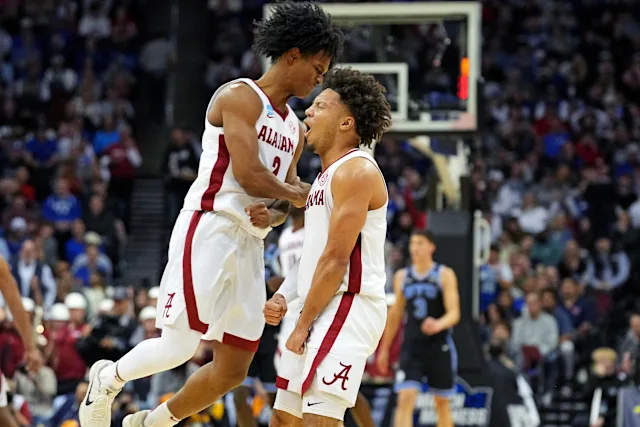As the 2024 NCAA Tournament enters the Elite Eight, the matchup between the No. 1 Duke Blue Devils and the No. 7 Alabama Crimson Tide is one that captures the essence of what March Madness is all about: high stakes, elite talent, and contrasting styles of play. Both teams have had outstanding seasons, but this game will ultimately decide who advances to the Final Four. Each team brings unique strengths to the court, and the contrasting styles between Duke’s classic brand of basketball and Alabama’s up-tempo, three-point-heavy offense will make this contest an unforgettable spectacle.
A Look at the Teams
Duke Blue Devils: Tradition Meets Excellence
Duke University, under the legendary Mike Krzyzewski, has long been considered one of the premier basketball programs in the nation. Even though Coach K retired in 2022, the Blue Devils have continued their dominance under new head coach Jon Scheyer. The team has embraced the tradition of strong defensive play, efficient offense, and a gritty, physical approach that has served them well throughout the years.
Duke’s journey to the Elite Eight has been nothing short of impressive. As the No. 1 seed in the NCAA Tournament, they’ve shown why they are widely regarded as one of the most balanced teams in college basketball. Duke’s strength lies in its depth and versatility, with a roster full of NBA-caliber players. Players like Kyle Filipowski, a skilled forward with the ability to stretch the floor, and Tyrese Proctor, an emerging star in the backcourt, have helped propel the Blue Devils into this position.
Defensively, Duke has maintained its reputation as one of the most formidable units in college basketball. The Blue Devils excel at locking down opponents in the paint, where they boast one of the best shot-blocking and rebounding duos in the nation. Defenders like Mark Mitchell and Ryan Young are invaluable to Duke’s defensive schemes, providing the physical presence needed to shut down opposing offenses.
Offensively, Duke has evolved over the years to become more dynamic. While the team still relies on its size and strength inside, they’ve become more efficient in their outside shooting, thanks to players like Jeremy Roach and Jacob Grandison. However, Duke’s bread and butter is still its inside game, where they punish smaller teams with their size and strength. Duke’s offensive system is designed to get the ball into the paint and create high-percentage scoring opportunities.
Alabama Crimson Tide: A Modern Powerhouse
The Alabama Crimson Tide, led by head coach Nate Oats, has become one of the most exciting teams in college basketball over the last few seasons. Known for their fast-paced, three-point-heavy offense, Alabama has adapted to the modern game by utilizing advanced analytics to optimize its offensive and defensive strategies. The Crimson Tide’s uptempo play style and high-volume shooting have helped them become one of the most potent offensive teams in the nation.
At 7th in the tournament, Alabama’s path to the Elite Eight has been one of dominance. Their ability to score quickly and efficiently has made them a nightmare for opponents. Alabama’s ability to spread the floor and create open shots from beyond the arc has given them a distinct advantage over teams that prefer a slower, more methodical pace. Players like Brandon Miller, one of the best young players in the country, and Mark Sears, a veteran presence in the backcourt, have been the focal points of Alabama’s offensive attack.
Defensively, Alabama has also been incredibly effective. The Crimson Tide employs a defense-first mentality that focuses on creating turnovers and turning defense into offense. Their full-court press, combined with their ability to contest shots both on the perimeter and in the paint, makes them one of the most well-rounded teams in the nation. The team’s aggressive defense is complemented by their ability to rebound effectively, providing them with multiple opportunities to push the ball up the court and score in transition.
Alabama’s offensive efficiency has been a major reason for their success. They rank among the top teams in terms of points per possession, and their effective field goal percentage is one of the best in the NCAA. While Alabama certainly leans heavily on its offense, their ability to lock down defensively and generate fast-break points gives them a balanced approach that makes them dangerous in every facet of the game.
Head-to-Head: How These Teams Match Up
This game will be an intriguing battle between two teams with distinct philosophies. Duke’s traditional style of play, built around tough defense and efficient scoring in the paint, will be put to the test against Alabama’s up-tempo offense and pressure defense. Let’s break down how each team’s strengths and weaknesses will play a role in this matchup.
Scoring and Offense
Alabama’s offense is built on speed, shooting, and efficiency. They play fast and take a high volume of three-point shots. This high-risk, high-reward approach has paid off throughout the season, as Alabama ranks among the top teams in points per game and effective field goal percentage. Alabama’s ability to get out in transition and score quickly is one of their greatest strengths. They have a wide range of shooters who can stretch the floor and make it difficult for opponents to defend. This type of offense poses a significant challenge for Duke, who has historically been a team that thrives in half-court settings.
Duke’s offense, however, is grounded in their ability to score inside the paint. With players like Filipowski and Mitchell, Duke has the size and strength to dominate on the boards and in the post. The Blue Devils also have a strong perimeter shooting game, but they are more reliant on inside scoring. They prefer to set up in the half-court, where they can use their size advantage to overpower opposing teams. In this matchup, Duke will need to establish an inside presence to slow down Alabama’s pace and prevent easy transition opportunities.
The key for Alabama will be to push the tempo and take advantage of their perimeter shooting. If they can hit their three-pointers and force Duke to chase them on defense, they will be able to dictate the pace of the game. On the other hand, Duke will need to limit Alabama’s fast breaks and keep the game at a slower, more controlled pace. They will also need to establish an inside presence early and often, as this is where they have a clear advantage.
Defense and Defensive Strategy
Defensively, Duke has the advantage in terms of size and shot-blocking ability. Their interior defense is among the best in the country, and they have the ability to limit opposing teams’ scoring in the paint. With Filipowski and Mitchell, Duke has two of the most imposing defenders in college basketball, and they can make it difficult for teams to score inside. Alabama will need to be efficient from the outside, as trying to score in the paint could be a difficult task against Duke’s big men.
Alabama’s defense, on the other hand, is built on pressure and forcing turnovers. They employ a full-court press that can disrupt opposing offenses and create fast-break opportunities. Their ability to generate turnovers and convert them into easy points is one of their greatest assets. Alabama’s defense has been effective at contesting shots both inside and on the perimeter, which could make it difficult for Duke to score consistently. If Alabama can get out in transition and force Duke into turnovers, they will be able to control the game.
The key for Duke will be to avoid turnovers and set up their offense in the half-court. If they can limit Alabama’s fast-break opportunities and force the Crimson Tide to play a more traditional game, they will have a much better chance of controlling the pace. On the defensive end, Duke will need to contest Alabama’s three-point shots and prevent easy transition points. It will be crucial for Duke’s defense to stay disciplined and not fall into Alabama’s trap of fast play and perimeter shooting.
Coaching and Experience
Both programs boast excellent coaching staffs, with Jon Scheyer leading Duke and Nate Oats at the helm of Alabama. Scheyer, a former player under Coach K, has quickly proven himself as a capable head coach, keeping Duke at the top of college basketball. Oats, known for his modern approach to the game, has transformed Alabama into one of the most dynamic teams in the country.
In terms of experience, Duke has a slight edge due to its long-standing success in the NCAA Tournament. The Blue Devils have a history of performing well in high-pressure situations, and their veterans, including Roach, will be crucial in helping Duke navigate the intense atmosphere of the Elite Eight. Alabama, though not as historically decorated, has a youthful energy and an aggressive style that can catch teams off guard. Oats’ ability to motivate his players and adapt to different styles of play has made him one of the rising stars in coaching.
Keys to Victory for Each Team
For Duke, the key to victory will be:
- Establishing an inside presence: Duke must utilize their size and strength to dominate in the paint and limit Alabama’s ability to score inside.
- Limiting turnovers: Duke cannot afford to give up easy points off turnovers, especially against a team like Alabama that thrives in transition.
- Contesting Alabama’s three-point shots: If Duke can defend the perimeter effectively, it will force Alabama to play a more methodical style.
For Alabama, the key to victory will be:
- Pushing the pace: Alabama must force Duke to play at their speed and avoid letting the Blue Devils control the tempo.
- Hitting three-pointers: Alabama’s offense is most effective when they are hitting from beyond the arc. If they can stretch the floor and score efficiently, they will have a major advantage.
- Creating turnovers: Alabama’s defense must pressure Duke’s ball handlers and force turnovers to generate fast-break points.



